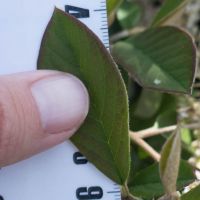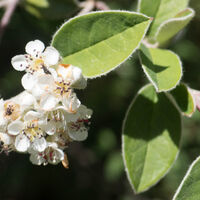cotoneasters
genus Cotoneaster
Member of
rose family (family Rosaceae)
dicots (class Magnoliopsida)
flowering plants (subphylum Angiospermae)
Except for extremely rare examples that I don't expect to encounter, there are no other wild species of this genus in the bay area.
Key features:
- plant height
- leaf length and width, thick or thin, veins sunken or not, color
- flower or fruit color (either works)
See also toyon (Heteromeles arbutifolia).
Cotoneaster integrifolius
- plant sprawling, ≤ 1 m
- leaf blade 5–15 mm, < 8 mm wide, narrowly oblanceolate, adaxially shiny, abaxially sparsely hairy, margins inrolled, tip blunt (notched)
- Nisene Marks, Santa Cruz, San Francisco, Marin
wall cotoneaster
Cotoneaster horizontalis
- shrub 0.5–1 m
- leaf blade blade 4–14 mm, widely elliptic; adaxially ± glabrous, shiny; abaxially sparsely appressed hairy, tip acute
- very rare: Mt. Tam
Edibility: Almost no one on the internet has tried cotoneaster fruit. Some sources say that it would take a large amount to harm an adult. But since the one taste tester seemed unimpressed, you might as well avoid them. [source]
Toxicity of cotoneaster (Cotoneaster spp.):
4 – Ingestion of these plants, especially in large amounts, is expected to cause serious effects to the heart, liver, kidneys or brain. If ingested in any amount, call the poison center immediately.
3 observed taxons / 2 unobserved taxons / 1 key
Locations: Months: For more details, use advanced search.
Chris’s observations: 41 (8 are research grade)
Taxon info: iNaturalist – Calflora – Jepson eFlora – FNA
Bay Area species: iNaturalist – Calflora


